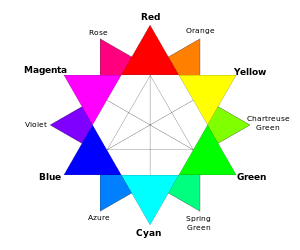Baker-Miller pink
Baker-Miller Pink, also known as P-618, Schauss pink, or Drunk-Tank Pink is a tone of pink which has been observed to reduce hostile, violent or aggressive behavior.[2] It was originally created by mixing one gallon (3.78 L) of pure white indoor latex paint with one pint (0.473 L) of red trim semi-gloss outdoor paint.[3]
| Baker-Miller Pink | |
|---|---|
| Hex triplet | #FF91AF |
| sRGBB (r, g, b) | (255, 145, 175) |
| CMYKH (c, m, y, k) | (0, 43, 31, 0) |
| HSV (h, s, v) | (344°, 43%, 100[1]%) |
| Source | Internet |
| ISCC–NBS descriptor | Strong purplish pink |
| B: Normalized to [0–255] (byte) H: Normalized to [0–100] (hundred) | |
Alexander Schauss did extensive research into the effects of the color on emotions at the Naval Correctional Facility in Seattle, and named it after the institute directors, Baker and Miller.[4]
History
In the late 1960s, Alexander Schauss, who now operates the American Institute for Biosocial Research in Tacoma, Washington, studied psychological and physiological responses to the color pink.[4][5] Schauss had read studies by the Swiss psychiatrist Max Luscher, who believed that color preferences provided clues about one's personality. Luscher noticed that color preferences shifted according to psychological and physiological fluctuations in his patients. Luscher asserted that color choice reflects emotional states. He theorized that one's color choices reflect corresponding changes in the endocrine system, which produces hormones. Schauss then postulated that the reverse might also be true; color might cause emotional and hormonal changes, and various wavelengths of light could trigger profound and measurable responses in the endocrine system.
In early tests in 1978, Schauss observed that color did affect muscle strength, either invigorating or enervating the subject, and even influenced the cardiovascular system.[4] Schauss began to experiment on himself, with the help of his research assistant John Ott. He discovered that a particular shade of pink had the most profound effect. He labeled this tone of pink "P-618".[6] Schauss noted that by merely staring at an 18 × 24 inch card printed with this color, especially after exercising, there would result "a marked effect on lowering the heart rate, pulse and respiration as compared to other colors."
In 1979, Schauss managed to convince the directors of a Naval correctional institute in Seattle, Washington to paint some prison confinement cells pink in order to determine the effects this might have on prisoners. Schauss named the color after the Naval correctional institute directors, Baker and Miller. Baker-Miller Pink is now the official name of the color.[4]
At the correctional facility, the rates of assault before and after the interior was painted pink were monitored. According to the Navy's report, "Since the initiation of this procedure on 1 March 1979, there have been no incidents of erratic or hostile behavior during the initial phase of confinement". Only fifteen minutes of exposure was enough to ensure that the potential for violent or aggressive behavior had been reduced, the report observed.[2]
Effects
Results of a controlled study by James E. Gilliam and David Unruh conflicted with Baker-Miller Pink's purported effect of lowering heart rate and strength.[3] While the results of Schauss's study at the Naval correctional facility in Seattle showed that Baker-Miller pink had positive and calming effect on prisoners; when the same pink was employed at the Santa Clara County Jail, the prison incident rate increased and even peaked compared to pre-pink months, despite a small decrease in the first month.[7] Some researchers believe that the symbolism of the femininity of pink would be a bias in the results of Schauss's studies, highlighting in particular the over-representation of male prisoners in the participants.[8]
In culture
The band Bakers Pink is named after the Baker-Miller pink phenomenon.
A 2013 book, entitled Drunk Tank Pink, is named for the color. Written by Adam Alter, a professor of marketing and psychology at New York University's Stern School of Business, the book describes how features of the environment—including colors—shape how people think, feel, and behave.[9]
A chapter in William Gibson's 2020 novel, Agency is entitled "Baker-Miller Pink" referring to the color a tangential character, Janice, has painted her living room.
See also
- List of colors
- Shades of pink
- Shades of magenta
References
- web.forret.com Color Conversion Tool set to hex code #FF91AF (Baker-Miller Pink):
- "Colors" by David Byrne Cabinet Magazine:
- "The Effects of Baker-Miller Pink on Biological, Physical and Cognitive Behaviour" by James E. Gilliam and David Unruh
- St. Clair, Kassia (2016). The Secret Lives of Colour. London: John Murray. p. 118–119. ISBN 9781473630819. OCLC 936144129.
- Pellegrini, Robert J.; Schauss, Alexander G.; Miller, Michael E. (1981). "Room color and aggression in a criminal detention holding cell: a test of the "tranquilizing pink" hypothesis". Orthomolecular Psychiatry. 10(3): 174–181.
- Schauss, Alexander G. (1981). "Application of behavioral photobiology to human aggression: Baker-Miller pink". The International Journal for Biosocial Research. 2: 25–27.
- http://orthomolecular.org/library/jom/1981/pdf/1981-v10n03-p174.pdf
- Genschow, Oliver; Noll, Thomas; Wänke, Michaela; Gersbach, Robert (2015-05-28). "Does Baker-Miller pink reduce aggression in prison detention cells? A critical empirical examination". Psychology, Crime & Law. 21 (5): 482–489. doi:10.1080/1068316X.2014.989172. ISSN 1068-316X.
- Alter, Adam. "Drunk Tank Pink". Archived from the original on 28 September 2013. Retrieved 24 September 2013.
